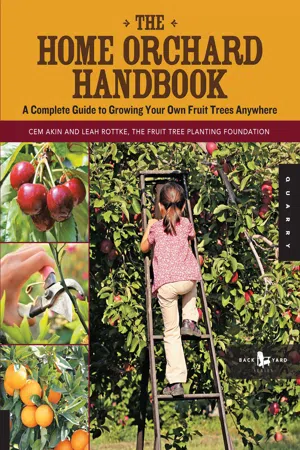![]()
ONE MIGHT SPECULATE THE NEED FOR entire armies of environmentalists, health crusaders, and animal welfare activists to accomplish this. Yet, there is a singular strategy that can kick-start the heart of this process all on its own—a global catalyst for a healthy planet, if we all act together, perfectly utilizing physics, chemistry, and the symbiotic means offered by Mother Nature to nourish the world and all its inhabitants. Best of all, it is a simple, grounding, long-lasting, Earth-connecting strategy that is part of a most enjoyable journey and rewarding destination: Plant a fruit tree, care for it, encourage everyone you know to do the same, and pass on the legacy.
Simply put, trees heal the planet, from filtering air pollutants to recharging groundwater to creating healthy microcosms in the soil. And it doesn’t stop there. If that tree is a fruit tree, harvest abounds for decades, sometimes centuries, improving health for generations. Excess harvests may be donated to local food banks or given to neighbors, promoting sustainability by displacing many environmental hazards associated with the mass commercial production, transportation, and packaging of most food sold in today’s markets.
“The best time to plant a tree was twenty years ago. The next best time is now.”
–CHINESE PROVERB
Plums ready for harvest
At the table, science shows that eating more fruits cuts the risk of major diseases.1 In the backyard, home orchards serve as a place to forge deep connections with family, friends, and nature. In the community, planting and maintaining fruit trees can be a truly holistic, tangible solution to many of the world’s critical problems.
Fruit trees play an important role in the history of Earth. Many wild varieties have been around for millions of years in various forms. Fossilized remnants from the olive’s ancestor date back 20 million years.2 Early incarnations of the plant that has become the modern-day Rosaceae family, which includes apples, pears, quinces, almonds, cherries, plums, and apricots, were present 40 to 50 million years ago.3
And perhaps the most fruitful symbiotic relationship ever between plant and animal goes back 80 million years, when fig wasps became the exclusive pollinators of fig trees—a relationship that exists to this day.4 Experts estimate that the earliest human domestication of fruit trees, especially olives, dates, and figs, occurred in the late Stone Age through the early Bronze Age (as early as about 9000 B.C.E. for figs).5
Fruit trees originated in the wild, ages ago.
Some trees, such as olives, can survive for more than a thousand years, making them living artifacts. Others, like apples and pears, can produce fruit for centuries. It has even been suggested that the longevity of domesticated fruit trees provides such a strong connection to the land that this bond contributed to the development of modern city-states and nations.7 Imagine, humankind being inspired to develop sophisticated social structures based partly on a desire to be close to their beloved orchards!
Indeed, a certain indescribable magic surrounds fruit trees, as flowers metamorphose into nature’s perfect foods, enchanting children and adults alike. The tree combines all the most amazing botanical processes to create a fruit so tasty that it can entice an animal to eat it and distribute the seed. What a concept!
To help share that magic and wonder, the basics of growing fruit trees in a home orchard are covered in the following chapters, including site and plant selection, planting techniques, and aftercare. These principles are applicable to nut trees as well. All instructions promote organic, humane methods, resulting in the most sustainable Earth- and animal-friendly orchards possible that set the highest standard for others to emulate.
The tranquility of a sunrise above fruit trees in the tropics
Imagine a place where you can have a summer picnic under the shade of a fruit tree, breathe the clean air it generates, watch the beautiful birds and other wildlife foraging in its canopy, and bring only an appetite for the healthy fruits growing overhead. Now imagine that place being in your own yard.
“To exist as a nation, to prosper as a state, and to live as a people, we must have trees.”
–THEODORE ROOSEVELT
Peach blossoms waiting to be transformed into fruit.
Home orchard sustainability, with bushels of organic harvest
ENVIRONMENTAL BENEFITS
To review the research showing just how beneficial trees are for the environment and the home orchard, let’s start with the air. Each year, a mature tree can produce up to 260 pounds (118 kg) of oxygen,8 remove harmful ozone pollutants from the lower atmosphere that contribute to smog, and sequester between 35 and 800 pounds (16 and 363 kg) of carbon dioxide from the air.9 Dwarf fruit trees are typically smaller in stature than shade trees, thus fall on the lower end of this range, while standard-size fruit trees much higher. Accordi...







